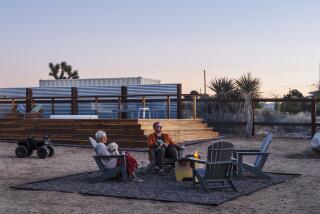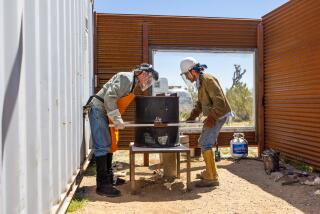Holy Web Page : In a remote part of New Mexico, Benedictine monks get on the Internet to spread the word.
ABIQUIU, N.M. — The Monastery of Christ in the Desert is a cluster of adobe buildings in a remote river canyon, where monks spend their days praying and working and their nights reading by kerosene lamps.
It’s also a stop on the information superhighway.
In a modern-day twist on the ancient tradition of monks as scribes, the little Benedictine monastery has a home page on the Internet’s World Wide Web.
Internet surfers can learn about monastic life, browse the monastery’s gift shop--even listen to a Gregorian chant.
Or they can request to be remembered in the prayers of the monks who gather in the chapel seven times daily, starting at 4 a.m.
“We get probably about 10 prayer requests a day--when we can get our phone to work,” said Brother Mary-Aquinas.
Located along the Rio Chama in the Santa Fe National Forest at the end of 13 miles of narrow, rutted dirt road, the Roman Catholic monastery has no phone or electric service.
It relies on cellular phones for its computer linkup. The only electricity, to the main building, is solar-generated. Heat is provided by burning wood.
In this isolated setting, the monks of Christ in the Desert carry on work begun thousands of years ago by the scribes who created and copied books--first on clay tablets, then papyrus, parchment and eventually paper.
As early as the 4th century, the scriptorium--the room where Christian monks did their copying--was a source of revenue for a monastery.
It was that age-old concern about supporting itself that propelled Christ in the Desert into cyberspace.
A couple of years ago, the monastery contracted to computerize library card catalogs.
In June, it joined the World Wide Web and advertised that it would design Web sites for others.
“After all,” says the monastery’s home page ad, “we’ve been making pages for 1,500 years.”
About eight monks do the computer work. Recent clients include a travel reservations company, a Christian singer and a Jungian conference in Switzerland.
“What we’re doing now is more creative, and that’s good for monks,” said the Rev. Philip Lawrence, prior of the monastery. “If you’re doing something that’s creative, it brings out a whole different aspect of the soul.”
Christ in the Desert’s home page is adorned with intricate and brightly colored images--reminiscent of the ornate decoration that marked the work of early Christian monks.
In the monastery’s scriptorium--a small room with whitewashed walls behind the kitchen--monks in simple, hooded tunics and bluejeans work quietly on computers. They observe the “work silence.” That means they talk only when necessary.
The monks--who call one another “Brother,” although some are priests--spend much of the day in silence. They are encouraged to chat only during a half-hour recreation period in the evening.
At least four hours a day is spent at work: cooking, laundry, woodcutting and other household chores, as well as weaving, carving, rosary-making and now computer work.
Four hours are spent in common prayer, considered the heart of community life, and another four are set aside for private prayer and reading.
“This work really fits into our tradition--the ancient tradition of monks illuminating information,” said Brother Mary-Aquinas, a 30-year-old former systems analyst.
“It’s just so ideal for our life. . . . We can stay here, out in the desert, and it fits into our schedule.”
Yahoo, one of the gateways to the World Wide Web, put the monastery’s home page on its list of “cool stuff.”
And several Internet surfers have contacted the monastery to say they’re interested in becoming monks.
“Cybervocations, we call it,” Brother Mary-Aquinas said with a laugh.
The Internet isn’t the monks’ only high-tech excursion.
A dozen members of the community recently went to an Albuquerque sound studio to record the chants that are a staple of their religious services.
While audiotapes made at the monastery are available through its gift shop, this will be the first compact disc--and the first time the monks have used state-of-the-art equipment to capture the centuries-old Gregorian and Byzantine chants.
The compact disc will be sold through the monastery’s gift shop and catalog.
Christ in the Desert’s gift shop and guest house used to provide enough operating revenue, but no longer. It costs about $200,000 a year to support the 25 monks, who come from seven countries, Lawrence said.
And the monastery is in the midst of a $2.5-million building campaign. The sleeping rooms, called cells, are scattered in small, poorly heated buildings; they will be concentrated in a 10,000-square-foot building attached to the chapel by an enclosed walkway.
With some monks in their 70s and winters that deliver plenty of snow and subzero temperatures, the improvements are a must, Lawrence said.
Each cell in the new building will be wired for a computer--looking toward the day when monks will get their spiritual reading matter from diskettes rather than books.
“It’s so obviously the way of the future,” Lawrence said.
The monastery’s Internet address is: https:www.christdesert.org
More to Read
Sign up for The Wild
We’ll help you find the best places to hike, bike and run, as well as the perfect silent spots for meditation and yoga.
You may occasionally receive promotional content from the Los Angeles Times.






